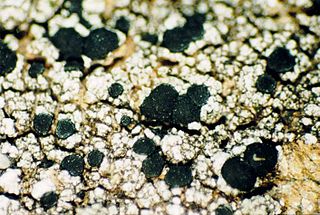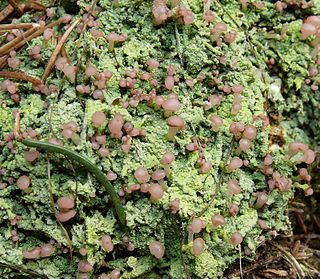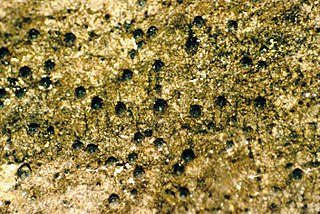
The Lecanoraceae are a family of lichenized fungi in the order Lecanorales. Species of this family have a widespread distribution.

The Teloschistaceae are a large family of mostly lichen-forming fungi belonging to the class Lecanoromycetes in the division Ascomycota. The family has a cosmopolitan distribution, although members occur predominantly in subtropical and temperate regions. Most members are lichens that either live on rock or on bark, but about 40 species are lichenicolous – meaning they are non-lichenised fungi that live on other lichens. Many members of the Teloschistaceae are readily identifiable by their vibrant orange to yellow hue, a result of their frequent anthraquinone content. The presence of these anthraquinone pigments, which confer protection from ultraviolet light, enabled this group to expand from shaded forest habitats to harsher environmental conditions of sunny and arid ecosystems during the Late Cretaceous.

The Baeomycetales are an order of mostly lichen-forming fungi in the subclass Ostropomycetidae, in the class Lecanoromycetes. It contains 8 families, 33 genera and about 170 species. As a result of molecular phylogenetics research published in the late 2010s, several orders were folded into the Baeomycetales, resulting in a substantial increase in the number of taxa.

Anaptychia is a genus of lichen-forming fungi in the family Physciaceae. Anaptychia species have brown, thin-walled spores with a single septum, and a prosoplechtenchymatous upper cortex.

Hypocenomyce is a genus of lichen-forming fungi in the family Ophioparmaceae. Species in the genus grow on bark and on wood, especially on burned tree stumps and trunks in coniferous forest. Hypocenomyce lichens are widely distributed in the northern hemisphere.

Phacopsis is a genus of lichenicolous (lichen-dwelling) fungi. They are parasites of members of the large lichen family Parmeliaceae, of which they are also a member. Originally proposed by Edmond Tulasne in 1852 to contain 3 species, Phacopsis now contains 10 species, although historically, 33 taxa have been described in the genus. Many of the species are poorly known, some of them having been documented only from the type specimen.

Haematomma is a genus of crustose lichens established by Abramo Bartolommeo Massalongo in 1852. It is the sole genus in the Haematommataceae, a family circumscribed by Josef Hafellner in 1984. Commonly called bloodstain lichens, the species assigned to this genus are widely distributed in tropical and temperate areas.
Caloplaca vainioi is a species of crustose lichen in the family Teloschistaceae. It is based on the name Placodium brebissonii var. microspora, collected by Friedrich Welwitsch in Angola and described by Edvard August Vainio in 1901. In 1979, lichenologists Josef Hafellner and Josef Poelt renamed this taxon to Caloplaca vainioi. Thorsten Lumbsch and colleagues indicated that this species is the same as Caloplaca cateileoides, and proposed placing the two in synonymy. However, Clifford Wetmore questioned the synonymy of these species, noting that their lichen spot tests and hymenium colour were different, and suggested that "further collections and study are necessary".

Arthrorhaphis is a genus of lichen-forming fungi in the monotypic family Arthrorhaphidaceae. It has 13 species. The genus was circumscribed by Theodor Magnus Fries in 1860. The family was proposed by lichenologists Josef Poelt and Josef Hafellner in 1976. Species in this family have a widespread distribution in temperate and montane habitats. They grow symbiotically with green algae, or parasitically on other lichens. The family Arthrorhaphidaceae has an uncertain taxonomic placement in the class Lecanoromycetes; that is, it is incertae sedis with respect to ordinal placement.

Scoliciosporum is a genus of lichens in the family Scoliciosporaceae.

Schaereria is a genus of lichen-forming fungi. It is the sole genus in the family Schaereriaceae, which itself is the only family in the Schaereriales, an order in the subclass Ostropomycetidae of the class Lecanoromycetes. Most Schaereria species are crustose lichens that live on rocks. Schaereria was first proposed by Gustav Wilhelm Körber in 1855 and was later taken up by other lichenologists despite periods of disuse.

Sporastatia is a genus of crustose lichens in the family Sporastatiaceae. It has four species. Sporastatia lichens are long-lived species that grow on siliceous or weakly calcareous rocks in arctic and alpine locales.
Pachyascus is the sole genus in the family Pachyascaceae. It contains a single species, the lichen Pachyascus lapponicus. Both the genus and species were described as new to science in 1968 by lichenologists Josef Poelt and Hannes Hertel. P. lapponicus was originally collected from Lapland, a province in northern Sweden. The lichen has several unusual characteristics: it grows exclusively along with the rock moss Andreaea, it bears goniocyst-like parts and produces tiny apothecia that stand in the leaf axils of the moss, and it has thick asci.
Halospora is a genus of lichenicolous (lichen-dwelling) fungi in the family Verrucariaceae. Species in the genus parasitise calcicolous crustose lichens, i.e., those that prefer lime-rich substrates.
Strangospora is a genus of lichen-forming fungi. It is the only genus in the family Strangosporaceae, which itself is of uncertain taxonomic placement in the Ascomycota. It contains 10 species.
Timdalia is a fungal genus in the family Acarosporaceae. It is a monotypic genus, containing the single species Timdalia intricata, a saxicolous (rock-dwelling), crustose lichen. This species was first formally described by Swedish lichenologist Adolf Hugo Magnusson in 1935, based on a collection made by Eduard Frey in Austria. It was initially classified in the genus Acarospora. Josef Hafellner circumscribed Timdalia to contain the species in 2001. It was initially placed in the family Lecanoraceae, but molecular phylogenetic studies showed Timdalia to belong in the Acarosporaceae. The genus name honours Norwegian lichenologist Einar Timdal.

Wetmoreana is a genus of lichen-forming fungi in the family Teloschistaceae. It has two crustose, saxicolous (rock-dwelling) species.
Helocarpaceae is a family of lichen-forming fungi in the subclass Lecanoromycetidae. The family is monotypic, and contains the single genus Helocarpon.
Caloplaca rinodinae-albae is a lichenicolous (lichen-dwelling) species of crustose lichen in the family Teloschistaceae, first described in 1987. This species is unique for its parasitic growth on the lichen Helmutiopsis alba. Characteristics of the lichen include its small, rounded, pale orange thalli and its ability to form larger patches through the confluence of individual thalli.











